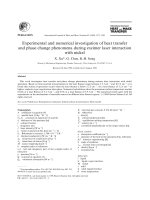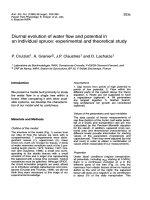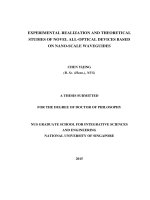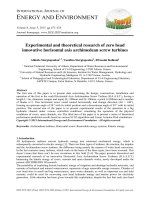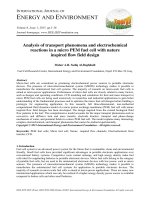Experimental and theoretical study of low cost PEM fuel cell catalysts
Bạn đang xem bản rút gọn của tài liệu. Xem và tải ngay bản đầy đủ của tài liệu tại đây (14.83 MB, 237 trang )
EXPERIMENTAL AND THEORETICAL STUDY
OF LOW COST PEM FUEL CELL CATALYSTS
POH CHEE KOK
NATIONAL UNIVERSITY OF SINGAPORE
2013
EXPERIMENTAL AND THEORETICAL STUDY
OF LOW COST PEM FUEL CELL CATALYSTS
POH CHEE KOK
(B.Sc.(Hons.)) University of Malaya
(M.Sc.) National University of Singapore
Supervisors: Prof. Feng Yuan Ping
Prof. Lin Jianyi
A THESIS SUBMITTED
FOR THE DEGREE OF DOCTOR OF PHILOSOPHY
DEPARTMENT OF PHYSICS
FACULTY OF SCIENCE
NATIONAL UNIVERSITY OF SINGAPORE
2013
Table of Contents
i
Table of Contents
Table of Contents i
Abstract vi
Acknowledgements ix
List of Abbreviations x
List of Tables xiii
List of Figures xiv
List of Publications xix
Chapter 1. Introduction 1
1.1 Motivation 1
1.2 Objectives 5
1.3 Methodology 7
1.3.1 Synthesis methods 7
1.3.1.1 Impregnation of precursors on catalyst support 7
1.3.1.2 Plasma enhanced chemical vapour deposition 7
1.3.1.3 Direct current (DC) sputtering and radio frequency (RF) magnetron sputtering 8
1.3.2 Experimental characterization 9
1.3.2.1 Scanning electron microscopy 9
1.3.2.2 Transmission electron microscopy 10
1.3.2.3 Raman spectroscopy 10
1.3.2.4 Fourier Transform InfraRed spectroscopy 11
1.3.2.5 X-ray diffraction 12
1.3.2.6 Brunauer, Emmett and Teller theory for specific surface area measurement 13
1.3.2.7 X-ray photoelectron spectroscopy and Ultraviolet photoelectron spectroscop 14
1.3.2.8 Cyclic voltammetry and Rotating disc electrode measurement 15
1.3.2.9 Electrochemical impedance spectroscopy(EIS) 17
Table of Contents
ii
1.3.3 Mathematical models 20
1.3.4 Density functional theory 23
1.3.4.1 A very brief description of the theory 23
1.3.4.2 Exchange-correlation (XC) potential 25
1.3.4.4 Pseudopotential 27
1.3.4.4 Cambridge Serial Total Energy Package code 29
1.4 Outline of the thesis 29
1.5 References 30
Chapter 2. Literature Background 33
2.1 Fuel Cells 33
2.1.1 A very brief history 33
2.1.2 Brief description of fuel cells 34
2.1.3 Mechanisms of fuel cell reactions 35
2.1.3.1 Hydrogen oxidation reaction 35
2.1.3.2 Oxygen reduction reaction 36
2.1.4 The structure of a PEM fuel cell 39
2.2 Design and synthesis of fuel cell catalysts 40
2.2.1 Design of fuel cell catalyst at microscale level 40
2.2.2 Design of fuel cell catalyst at nanoscale level 45
2.2.3 Design of fuel cell catalyst at molecular level 50
2.3 Conclusions 54
2.4 References 54
Chapter 3. Vertically Aligned Carbon Nanotubes Supported Pt catalyst 59
3.1 Efficient utilization of Pt catalyst 60
3.2 Vertically aligned carbon nanotubes as fuel cell catalyst supports 61
3.3 Preparation of the highly order-structured membrane electrode assembly 62
3.3.1 Growth of VACNTs on aluminum foil 62
3.3.2 Pt electrocatalyst deposition on VACNT film 63
Table of Contents
iii
3.3.3 Fabrication of single PEM fuel cell 64
3.3.4 Physical Characterization 64
3.3.5 Measurements of fuel cell performance 64
3.4 Physical properties of the Pt/VACNT MEA 65
3.5 Single cell performance of Pt/VACNT MEA 68
3.6 Mathematical analysis of the cathode catalyst layer 82
3.7 Conclusions 84
3.8 References 84
Chapter 4. Self-humidifying catalyst 87
4.1 Humidification issue in air-breathing PEMFCs 88
4.2 Preparation and characterization of functionalized carbon blacks 90
4.3 Fabrication and characterization of air-breathing PEMFCs 91
4.3 Physical and chemical properties of the catalyst 93
4.4 Performance evaluation of the Air breathing PEM fuel cells 97
4.5 Mathematical analysis of the Air breathing PEM fuel cells 102
4.6 Conclusions 107
4.7 References 108
Chapter 5. Metal Doped Order Mesoporous Carbon Supports 111
5.1 CO Poisoning in DMFCs 112
5.2 Preparation and characterization of the catalysts 115
5.2.1 Preparation of the supports 115
5.2.1.1 Ordered mesoporous carbon 115
5.2.1.2 RuC 115
5.2.1.3 FeRuC 116
Table of Contents
iv
5.2.1.4 CoRuC 116
5.2.1.5 NiRuC 116
5.2.2 Preparation of Pt catalysts 116
5.2.3 Characterization of the supports and the Pt catalysts 117
5.3 Physical Properties of the supports and Pt catalysts 119
5.4 Electrochemical Performance of Pt catalysts 134
5.5 Conclusions 140
5.6 References 141
Chapter 6. Pt-W
x
C Nano-Composites 145
6.1 Tungsten carbide for ORR 146
6.2 Preparation and Characterization of Pt-W
x
C Nano-Composites 147
6.3 Morphological and structural properties of the catalysts 150
6.4 Chemical composition and electronic properties 156
6.5 ORR in alkaline medium 160
6.6 Conclusions 168
6.7 References 168
Chapter 7. First Principle Study of the metal-support interactions and O
2
dissociation on single-atom Pt/W
x
C(100) 171
7.1 Single-site Heterogeneous Catalysis by tungsten carbide 172
7.2 Computational method and details 173
7.3 Bulk properties of W
x
C structures 175
7.4 W
x
C (100) surfaces 178
7.5 Adsorption and Stability of Pt atom on W
x
C (100) surfaces 183
Table of Contents
v
7.6 Dissociative adsorption of O
2
on Pt-W
x
C (100) systems 193
7.7 Conclusions 202
7.8 References 203
Chapter 8. Conclusions And Future Work 207
8.1 Conclusions 207
8.2 Future work 209
Abstract
vi
Abstract
As an electrochemical energy converter, fuel cell is undoubtedly
efficient and low in emission of pollutants. Nevertheless, there are still barriers
for the commercialization of fuel cell. The most important challenge is the
cost of the catalyst. Extensive research is required to enhance the performance
of the electrocatalyst to reduce the energy cost. In this thesis, polymer
electrolyte membrane fuel cell (PEMFC) catalysts are designed to address four
different issues and enhance the performance of fuel cell catalyst to lower the
fuel cell cost.
Pt decorated vertically aligned carbon nanotubes (VACNTs) were
synthesized and employed as highly ordered catalyst layer for optimization of
mass and charge transports in H
2
/O
2
PEMFC. VACNTs were grown on
aluminium foil by plasma enhanced chemical vapour deposition using Fe/Co
bimetallic catalyst. Pt nanoparticles were deposited using physical deposition
method. Membrane electrode assembly (MEA) fabricated using this method
with a low Pt loading of 35 µg.cm
-2
showed an excellent performance,
comparable to that of a commercial catalyst with 400 µg cm
-2
Pt on carbon
black. This is attributed to the unique structure of the catalyst support that
forms a highly ordered catalyst layer, leading to highly efficient Pt utilization.
Citric acid modified carbon black (CA-CB) was used as the Pt catalyst
support for self-humidifying air breathing proton exchange membrane fuel
cells (AB-PEMFCs). Pt/CA-CB is highly hydrophilic due to the functional
groups attached on the carbon support, hence it is able to retain water in the
MEA and prevent the drop in internal ionic conductivity. 23.4% enhancement
in the output power density can be achieved by using Pt/CA-CB in place of
commercial catalyst when oblique slit cathodes are used.
Metal-carbon nanocomposites (NiRuC, FeRuC, and CoRuC) as Pt
catalyst supports were synthesized via template strategy. Bimetallic
nanoparticles (Ni-Ru, Fe-Ru, and Ru-Co) were homogenously dispersed in
carbon matrix and Pt nanoparticles with a size of less than 5 nm size were
highly distributed on the nanocomposites surface. Pt/CoRuC catalyst showed
Abstract
vii
better catalytic activity than Pt/FeRuC and Pt/NiRuC and its performance for
direct methanol fuel cell (DMFC) is closer to the commercial PtRu catalyst
that has a slightly higher metal loading.
W
x
C and Pt-W
x
C (x=1 or 2) nano-catalysts supported on carbon black
were synthesized using co-impregnation and thermal reduction method. Pt
loading in carbon-supported Pt-W
x
C catalysts was reduced to as low as 5%
while its oxygen reduction reaction (ORR) performance remained comparable
to that of a commercial 20% Pt/C catalyst. W
x
C serves as an electronic
promoter by preventing Pt from oxidation and modifying Pt d-band structure.
W
x
C also prevents agglomeration of Pt particles.
To understand the role of W
x
C as the support of single-atom platinum
catalyst the investigation on the adsorption properties of Pt on W
x
C(100)
surfaces and the impact on O
2
dissociation was carried out using DFT
calculations. Pt atoms were found to be stable at various adsorption sites on
W
x
C surfaces and resistant to agglomeration. The strong adsorption of Pt
atoms on the surfaces lowers the surface energies of the Pt/W
x
C(100) systems
and causes the downshift of d-band centre of the surface slabs. The adsorption
of Pt on W
x
C(100) systems can generate new interface sites, where the
reaction path on this new system is thermodynamically favourable even at
high coverage.
This dissertation contains several chapters that were published and
resulted from collaborations with different researchers. For the work presented
in Chapter 3, I am involved in many of the material fabrication (i.e. Pt coating
on VACNT, fabrication of MEA), data collection and analysis (SEM, TEM,
Raman spectroscopy and PEM fuel cell testing), as well as concept formation
(i.e. the idea of improving Pt dispersion by sputtering on front and back of
CNT film, impregnation of Nafion solution and that improvement in mass
transport can be achieved through the 1-D structure of CNTs). Dr. Tian
Zhiqun was the lead investigator in this work, Dr. Lim San Hua was
responsible for the growth of VACNTs, while the mathematical modelling in
this chapter was mainly done by Dr. Xia ZeTao with discussion with the other
authors. For Chapter 4, I am responsible for all major areas of material
Abstract
viii
synthesis, concept formation, data collection and analysis. Dr. Bussayajarn
contributed in the characterization of the catalyst performance in the air-
breathing fuel cell. The concept formation, data collection and analysis of
Chapter 5 were mainly contribution from myself, except for the material
synthesis which was done by Dr. Su Fabing. In Chapter 6, I am responsible for
the material synthesis, concept formation, data collection and analysis. Co-
authors have contributed in discussion on the scientific ideas. The DFT
calculations, analysis of the results and the formation of the idea in Chapter 7
are mainly my contribution with the help through discussion with the co-
authors.
Acknowledgements
ix
Acknowledgements
I would like to take this opportunity to express my sincere gratitude to
my supervisors, Prof. Lin Jianyi and Prof. Feng Yuan Ping for their patience
and guidance during my PhD candidature. Their insightful suggestions and
comments have guided me through my doctoral study.
Special thanks are due to my colleagues from ICES who have given
me assistance and advices during my PhD candidature: Dr. Armando Borgna,
Dr. Chen Luwei, Dr. Lim San Hua, Dr. Tian Zhiqun, Dr. Yang Huanping, Dr.
Catherine Choong, Dr. Poernomo Gunawan, Ms. Wang Zhan, Mr. Kenneth
Wong, Mr. Yeo Wen Cong, Mr. Ritchie Chan and Mr. Lee Koon Yong, not
forgetting my ex-colleague Dr. Su Fabing, for his invaluable advices and our
collaborator from Republic polytechnic, Dr. Xia Zetao who helps me in the
mathematical modelling.
I would also like to show my appreciation to my fellow graduate
students, Dr. Tang Zhe, Dr. Lai Linfei, Mr. Liu Jilei, Dr. Daniel Ong and Dr.
Gavin Chua who have helped me during my study.
Finally, I would like to thank my parents and my wife, Jac for their
support and understanding.
List of Abbreviations
x
List of Abbreviations
AB-PEMFC
Air breathing polymer electrolyte membrane fuel cell
AAEMFC
Alkaline anion exchange membrane fuel cells
BJH
Barrett-Joyner-Halenda
BE
Binding energy
BFGS
Broyden–Fletcher–Goldfarb–Shanno
BET method
Brunauer-Emmett-Teller method
CASTEP
Cambridge Serial Total Energy Package
CNF
Carbon nanofiber
CNT
Carbon nanotubes
CP
Carbon paper
CCL
Cathode catalyst layer
CVD
Chemical vapour deposition
CA-CB
Citric acid modified carbon black
CV
Cyclic voltammetry
DFT
Density functional theory
DOS
Density of states
DC
Direct current
DMFC
Direct methanol fuel cell
EAA
Electrochemical active area
EIS
Electrochemical impedance spectroscopy
EELS
Electron energy loss spectroscopy
ESCA
Electron spectroscopy for chemical analysis
GDL
Gas diffusion layer
GGA
Generalized gradient approximation
HSC
High surface area carbon
HGCS
Hollow graphitic carbon sphere
ILTEM
Identical location transmission electron microscopy
ICP-MS
Inductive-coupled plasma mass spectrometer
K-L plot
Koutecky-Levich plot
LST
Linear synchronous transit
LEED
Low energy electron diffraction
List of Abbreviations
xi
MEA
Membrane electrode assembly
MOR
Methanol oxidation reaction
MPS
Molecular precursor state
OCV
Open circuit voltage
OMC
Ordered mesoporous carbon
ORR
Oxygen reduction reaction
PDOS
Partial density of states
PBE
Perdew-Burke-Ernzerhof
PECVD
Plasma enhanced chemical vapour deposition
PEMFC
Polymer electrolyte membrane fuel cell or proton exchange
membrane fuel cell
PANI
Polyaniline
PEMFC
Polymer electrolyte membrane fuel cell
PPy
Polypyrrole
PTFE
Polytetrafluoroethylene
PSD
Pore size distribution
Powder diffraction file
QST
Quadratic synchronous transit
RF
Radio frequency
RHE
Reference hydrogen electrode
SCE
Saturated calomel electrode
SEM
Scanning electron microscopy
TDS
Thermal desorption spectroscopy
TGA
Thermogravimetric analysis
TDOS
Total density of states
TMC
Transition metal carbides
TS
Transition state
TEM
Transmission electron microscopy
UPS
Ultraviolet photoelectron spectroscopy
VACNT
Vertically aligned carbon nanotubes
XANES
X-ray absorption near edge spectroscopy
XAS
X-ray absorption spectroscopy
XRD
X-ray diffraction
List of Abbreviations
xii
XPS
X-ray photoelectron spectroscopy
List of Tables
xiii
List of Tables
Table 3.1 Performance comparison of Pt catalyst on VACNTs as anodes and
cathodes in PEM fuel cells
a
70
Table 4.1 Physical and electrochemical properties of the 40 wt% Pt/CA-CB
and 40 wt% Pt/C-Com. 97
Table 4.2 Electrode-kinetic and mass-transfer parameters for MEAs tested
using oblique slit cathodes. Same GDL with 30% PTFE content was used for
all MEAs. 103
Table 4.3 Electrode kinetic and mass transfer parameters for MEAs tested
using circular opening cathodes. NRE 212 was used for all MEAs. 104
Table 5.1 Pore structure properties of all the supports. 120
Table 5.2 Comparison of the fitting parameters according to impedance model
for the catalysts. 140
Table 7.1 The bulk properties of the W
x
C structures including the values
obtained experimentally or by calculation from other groups as comparison.
176
Table 7.2 The binding energies of Pt on the W
x
C(100) structures with respect
to the chemical potentials of isolated Pt atom and bulk Pt and the position of
the d-band centre of Pt/W
x
C(100) structures with respect to the Fermi level.
186
Table 7.3 Binding energies of the substitutional adsorption of Pt atoms at W
and C vacancy sites in bulk W
x
C. 188
Table 7.4 Comparison of parameters of Pt/W
x
C(100) surfaces 202
List of Figures
xiv
List of Figures
Figure 1.1 Schematic diagram of the radio frequency PECVD system used for
the growth of CNTs. 8
Figure 1.2 Illustration of a three electrode electrochemical cell setup. 16
Figure 1.3 Nyquist plots and equivalent models for (a) purely capacitive cell,
(b) simplified Randles cell and (c) Randles cell. 18
Figure 2.1 Construction of a single cell for PEM fuel cell 40
Figure 3.1 Schematic illustration of synthesis of Pt catalyst on VACNTs and
fabrication of MEA. 63
Figure 3.2 (a) Images of Al foil before and after VACNT growth and (b) SEM
and (c) TEM images and (d) Raman spectra of VACNTs grown on Al foil. 66
Figure 3.3 SEM and TEM images of Pt deposited on VACNTs. 67
Figure 3.4 Image of Pt/VACNTs transferred from Al foil onto Nafion©
membrane. 68
Figure 3.5 SEM images of Pt catalyst on VACNTs transferred onto Nafion©
membrane by hot press. 68
Figure 3.6 Polarization curves and power density of single PEM cells using
Pt/VACNTs film as cathode: (a) effect of area density of VACNTs (b) effect
of Nafion© content in the Pt/VACNTs film (c) effect of Pt loading in
Pt/VACNTs. 73
Figure 3.7 SEM images of VACNTs prepared using different amount of FeCo
catalyst on Al foil 74
Figure 3.8 SEM images of Pt/VACNTs with various Pt loading (a and b) 6
µg.cm
-2
, (c and d) 30 µg.cm
-2
and (e and f) 50 µg.cm
-2
. 77
Figure 3.9 TEM images of Pt deposited on both sides of VACNTs with Pt
loading of 20µg.cm
-2
on the front side and 15µg.cm
-2
on the back side. 78
Figure 3.10 Polarization curves and power density of single PEM fuel cells
with Pt/VACNTs=30µg and Pt/VACNTs=35µg(F-20 µg, B-15 µg) as anodic
electrodes. 79
Figure 3.11 Performance comparison of single PEM fuel cells fabricated fully
by Pt/VACNTs= 35µg(F-20µg, B-15µg)films and commercial Johnson
Matthey 40% Pt/C powder with the Pt loading of 400 µg/cm
2
. 80
Figure 3.12 Schematic drawings of the electrode structure of Pt catalyst on
carbon powder (a) and Pt catalyst on VACNTs film (b). 82
List of Figures
xv
Figure 3.13 Commercial John Matthey 40 wt% Pt/C catalyst. 82
Figure 3.14 Simulated polarization curves and effectiveness factor of Pt
utilization of ordered VACNTs-based CCL with Pt loading of 35 µg.cm
-2
and
random carbon power-based CCL with Pt loading of 400 µg.cm
-2
. 84
Figure 4.1 (a) Schematic illustration of the experimental setup for air-
breathing PEMFC testing. (b) Two open cathode designs: Oblique slit (left)
and Circular opening (right) 92
Figure 4.2 Size distributions of Pt nanoparticles supported on Vulcan XC72R:
(a) TEM image of commercial catalyst Pt/C-Com; (b) TEM of Pt/CA-CB. (c)
Histograms of particles size distribution derived from TEM studies of Pt/CA-
CB (blue) and Pt/C-Com (red). (d) X-ray diffraction patterns of Pt/CA-CB
(blue) and Pt/C-Com (red). 93
Figure 4.3 Infrared transmittance spectra of supported Pt/C catalysts and
carbon supports: [1] As-purchased Vulcan XC-72R, [2] Pt/C-Com, [3] CA-CB,
and [4] Pt/CA-CB. 95
Figure 4.4 Comparison of the dispersion of 10 mg of citric acid treated XC-
72R (CA-CB) and as-purchased Vulcan XC-72R (CB) in de-ionized water
after ultrasound treatment for 30s. 95
Figure 4.5 Cyclic voltammtry (CV) curves of the Pt catalysts supported on the
commercial carbon, Pt/C-Com and the Pt on citric acid modified catalyst
Pt/CA-CB. 96
Figure 4.6 (a) Polarization curves of the Pt/CA-CB and Pt/C-Com catalysts on
the AB-PEMFC Stack with oblique slit cathodes (see schematic diagram in
inset) employing the Nafion© membrane NRE 212 (■ and ▲) and NRE 211(■
and ▲) respectively. Solid lines are the corresponding fits for the
experimental data. (b) Power densities curves of the four MEAs consisting of
Pt/CA-CB and Pt/C-Com with NRE212 and NRE211 respectively. 98
Figure 4.7 (a) Polarization curves of Pt/CA-CB and Pt/C-Com with circular
opening cathodes, NRE212 membrane and 30 wt% PTFE GDL. The data
obtained from ElectroChem Pt/C catalysts under identical conditions are
included as a reference. (b) Power density curves of Pt/CA-CB and Pt/C-Com
with circular opening cathodes, NRE212 membrane and GDL with 30 wt%
PTFE. 100
Figure 4.8 (a) Polarization curves of Pt/CA-CB and Pt/C-Com fabricated on
GDL with 10% PTFE (using NRE212 and circular opening cathode). (b)
Power densities curves of Pt/CA-CB and Pt/C-Com fabricated on GDL with
10% PTFE (using NRE212 and circular opening cathode). 101
Figure 4.9 Mass-transfer impedance for the polarization curves of AB-PEMFC
with circular opening design. 107
List of Figures
xvi
Figure 5.1 An illustration scheme of the nanostructured trimetallic Pt catalyst
preparation procedure. (a) Pristine SBA-15 template, (b) SBA-15 template
impregnated with a metal precursor, (c) infiltration of carbon precursor in the
silica pores, (d) carbon matrices with metal particles (metal-doped OMC) after
the removal of SBA-15, (e) Pt deposition on the metal-doped OMC. 115
Figure 5.2 Adsorption-desorption isotherms (a) and PSD curves (b) of all the
supports (for clarity, the isotherms of OMC, RuC, FeRuC, and CoRuC, were
vertically shifted for 350, 350, 150 and 50 cm
3
.g
-1
, respectively.). 120
Figure 5.3 Thermogravimetric curves of all the supports. 121
Figure 5.4 XRD patterns of all supports. 121
Figure 5.5 TEM images of RuC (a and b), FeRuC (c and d), CoRuC (e and f),
and NiRuC (g and h). 123
Figure 5.6 Thermogravimetric curves of all the Pt catalysts. 123
Figure 5.7 XRD patterns of all the Pt catalysts. 125
Figure 5.8 TEM images of Pt/OMC (a and b), Pt/RuC (c and d), Pt/FeRuC (e
and f), Pt/CoRuC (g and h), Pt/NiRuC (i and j), and JM (k and l). 128
Figure 5.9 XPS survey spectra of the elements on the Pt catalysts: (a) C1s, (b)
Pt4f, and (c) Ru3p
3/2
. 129
Figure 5.10 XPS survey spectra of the Pt 4f: (a) Pt/FeRuC, (b) Pt/CoRuC, (c)
PtNiRuC, (d) PtRuC, (e) Pt/OMC, and (f) JM. 131
Figure 5.11 XPS survey spectra of the Ru 3p: (a) Pt/FeRuC, (b) Pt/CoRuC, (c)
PtNiRuC, (d) PtRuC, and (e) JM. 132
Figure 5.12 XPS survey spectra of the elements on the Pt catalysts: (a) Fe 2p
of Pt/FeRuC, (b) Co 2p
3/2
of Pt/CoRuC, (c) Ni 2p
3/2
of Pt/NiRuC. 133
Figure 5.13 (a) Cyclic voltammograms of the catalysts measured in the
electrolytes of 0.5 M H
2
SO
4
at a scan rate of 50 mV.s
-1
, (b) Cyclic
voltammograms of the catalysts measured at a scan rate of 20 mV.s
-1
in
electrolytes of 0.5 M CH
3
OH + 1.0 M H
2
SO
4
, (c) CO anodic stripping
voltammograms of the catalyst in 0.5 M H
2
SO
4
measured at a scan rate of 20
mV s
-1
, and (d) EIS data of catalysts in 0.5 M H
2
SO
4
+ 1.0 M CH
3
OH solution
at 0.4 V, the solid lines are the fitted curves for the corresponding catalysts.
136
Figure 5.14 Equivalent circuit for modelling the Faradaic impedance on
methanol oxidation reaction. 139
Figure 6.1 TGA curves for the catalysts (a) 5Pt-CA-CB; (b) 20Pt-CA-CB; (c)
Pt/C-ETEK; (d) 20W
x
C-CA-CB; (e) 5Pt-W
x
C/CA-CB. 151
List of Figures
xvii
Figure 6.2 TEM images of the catalysts : (a) 5Pt/CA-CB; (b) 20Pt/CA-CB; (c)
Pt/C-ETEK; (d ) 20W
x
C/CA-CB; (e) 5Pt-W
x
C/CA-CB; (f) high magnification
TEM image of 20Pt/CA-CB, in which Pt nano-particles with (111) inter-
planar spacing of 0.23 nm are observable; (g) high magnification TEM image
of 20W
x
C/CA-CB, in which the nanoparticles of WC (with WC (101
1) inter-
planar spacing of 0.19 nm) and W
2
C (W
2
C (0002) with spacing = 0.24 nm) are
identified; and (h) high magnification TEM image of 5Pt-W
x
C/CA-CB.
Crystalline domains of Pt (111) and W
2
C (101
2) with spacing = 0.18 nm are
observable. 154
Figure 6.3 XRD spectra of (a) Pt/C-ETEK (top), 5Pt/CA-CB (middle) and
20Pt/CA-CB (bottom); (b) 20W
x
C/CA-CB (top) and 5Pt-W
x
C/CA-CB
(bottom) 155
Figure 6.4 XPS spectra of 5Pt/CA-CB, 20Pt/CA-CB, Pt/C-ETEK, 20W
x
C/CA-
CB and 5Pt-W
x
C/CA-CB catalysts: (a) wide scan, (b) and (c) C 1s, (c) and (d)
O 1s, (e) Pt 4f, and (f) W 4f. 159
Figure 6.5 RDE voltammetry curves for oxygen reuction on 5Pt/CA-CB,
20Pt/CA-CB, Pt/C-ETEK, 20W
x
C/CA-CB and 5Pt-W
x
C/CA-CB coated
electrodes in O
2
saturated 0.1 M KOH at scan rate of 10 mV.s
-1
. 162
Figure 6.6 UPS He II spectra of three different catalysts: 20W
x
C/CA-CB
(green color), 20Pt/CA-CB (red) and 5Pt-W
x
C/CA-CB (black). The spectra
have been normalized with respect to the C 2p peak at 8 eV binding energy.
162
Figure 6.7(a) KL plots for oxygen reduction on 5Pt/CA-CB, 20Pt/CA-CB,
Pt/C-ETEK, 20W
x
C/CA-CB and 5Pt-W
x
C/CA-CB coated electrodes at 0.867
V. (b) The potential dependence of the number of electrons transferred per O
2
molecule. 164
Figure 6.8 Cyclic voltammograms of 5Pt/CA-CB, 20Pt/CA-CB, Pt/C-ETEK,
20W
x
C/CA-CB and 5Pt-W
x
C/CA-CB in Ar saturated 0.1M KOH at a scan rate
of 20 mV s
-1
. 165
Figure 6.9 CV cycling of a) Pt/C-ETEK and b) 5Pt-W
x
C/CA-CB in O
2
saturated 0.1 M KOH solution at a scan rate of 10 mVs
-1
. ORR curves
measured at 2000 rpm in O
2
saturated 0.1 M KOH solution at a scan rate of 10
mV s
-1
for c) Pt/C-ETEK and d) 5Pt-W
x
C/CA-CB. 167
Figure 7.1 Total DOS and projected DOS of different bulk W
x
C structures
with Fermi energy at 0 eV. 177
Figure 7.2 a) Total DOS of the W
x
C(100) slabs and the corresponding bulk
(dotted lines). b) PDOS of the W
x
C(100) slabs. 180
Figure 7.3 Surface energies of the W
x
C(100) slabs. Dotted lines represent the
surface energy of slabs with C-terminated surface, dash lines represent the
surface energy of slabs with W-terminated surface and solid lines represent
List of Figures
xviii
surface energy of slabs with stoichiometric surface. C-rich surface means that
the chemical potential of the surface is close to that of graphite. 182
Figure 7.4 Stable adsorption sites for Pt on the W
x
C(100) slabs 185
Figure 7.5 Surface energies of Pt deposited a) h-WC(100)_C, b) h-
WC(100)_W, c) α-W
2
C(100)_C, d) α-W
2
C(100)_W, e) β-W
2
C(100)_C, f) β-
W
2
C(100)_W, g) γ-W
2
C(100)_C, h) γ-W
2
C(100)_W, i) ε-W
2
C(100)_WC and
j) c-WC(100)_WC slabs at various adsorption sites. Note that the chemical
potential of isolated Pt atom is higher than the Pt in the bulk metal. 190
Figure 7.6 Pt binding energies plotted against the d-band centres for the
Pt/W
x
C(100) systems. 192
Figure 7.7 PDOS of Pt/α-W
2
C-(100)_C structures with different Pt adsorption
sites. The bottom graph shows the PDOS of clean α-W
2
C-(100)_C slab. The
vertical lines below the Fermi level (dotted line at 0 eV) are the position of d-
band centres of respective structures. 193
Figure 7.8 The O
2
MPS, transition state and atomic O adsorption on
Pt/W
x
C(100) with the heats of reaction and activation energies for different
adsorption geometries of Pt atoms. 200
Figure 7.9 The molecular precursor and transition state energies along the
pathways depicted in Figure 7.8. The energy zero is taken to be the energy of
the gas phase O
2
molecule. 201
List of Publications
xix
List of Publications
[1] C. K. Poh, S.H. Lim, J. Lin, Y.P. Feng, Tungsten carbide supports for
single-atom Platinum based fuel cell catalysts: First Principle study on the
metal-support interactions and O
2
dissociation on W
x
C low-index surfaces.
Submitted to Journal of Physical Chemistry C (see Chapter 7)
[2] C. K. Poh, S. H. Lim, Z. Tian, L. Lai, Y. P. Feng, Z. Shen, J. Lin, Pt-W
x
C
nano-composites as an efficient electrochemical catalyst for oxygen reduction
reaction. Nano Energy 2013, 2 (1), 28-39. (see Chapter 6)
[3] F. Su, C. K. Poh, J. Zeng, Z. Zhong, Z. Liu, J. Lin, Pt nanoparticles
supported on mesoporous carbon nanocomposites incorporated with Ni or Co
nanoparticles for fuel cells. Journal of Power Sources 2012, 205, 136-144.
[4] L. Lai, J. R. Potts, D. Zhan, L. Wang, C.K. Poh, C. Tang, H. Gong, Z.
Shen, J. Lin, R. S. Ruoff, Exploration of the active center structure of
nitrogen-doped graphene-based catalysts for oxygen reduction reaction.
Energy and Environmental Science 2012, 5 (7), 7936-7942.
[5] C. K. Poh, Z. Tian, J. Gao, Z. Liu, J. Lin, Y. P. Feng, F. Su,
Nanostructured trimetallic Pt/FeRuC, Pt/NiRuC, and Pt/CoRuC catalysts for
methanol electrooxidation. Journal of Materials Chemistry 2012, 22 (27),
13643-13652. (see Chapter 5)
[5] L. Lai, L. Wang, H. Yang, N. G. Sahoo, Q. X. Tam, J. Liu, C. K. Poh, S. H.
Lim, Z. Shen, J. Lin, Tuning graphene surface chemistry to prepare
graphene/polypyrrole supercapacitors with improved performance. Nano
Energy 2012, 1 (5), 723-731.
[6] S. H. Lim, Z. Li, C. K. Poh, L. Lai, J. Lin, Highly active non-precious
metal catalyst based on poly(vinylpyrrolidone)- wrapped carbon nanotubes
complexed with iron-cobalt metal ions for oxygen reduction reaction. Journal
of Power Sources 2012, 214, 15-20.

